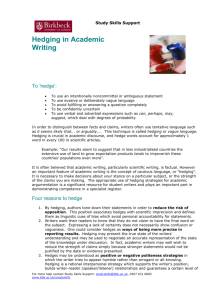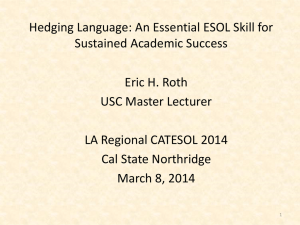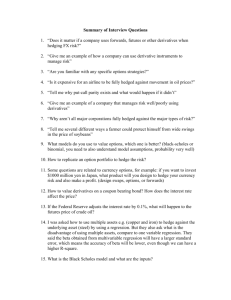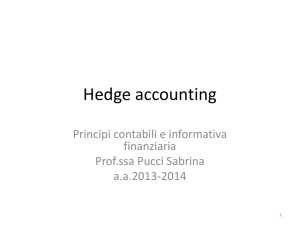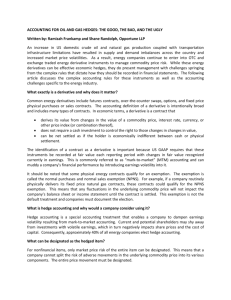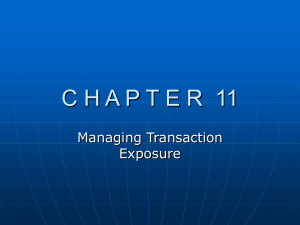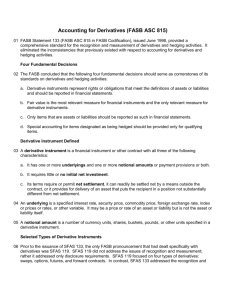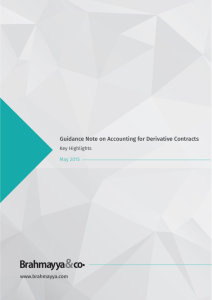Referee`s Report on
advertisement
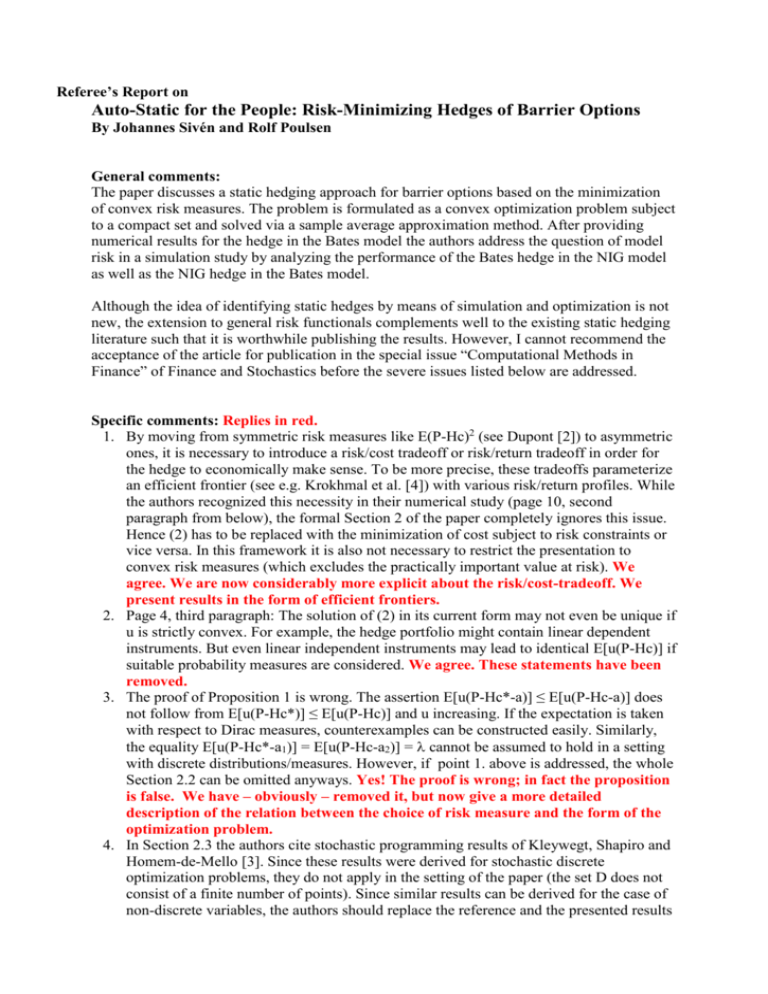
Referee’s Report on Auto-Static for the People: Risk-Minimizing Hedges of Barrier Options By Johannes Sivén and Rolf Poulsen General comments: The paper discusses a static hedging approach for barrier options based on the minimization of convex risk measures. The problem is formulated as a convex optimization problem subject to a compact set and solved via a sample average approximation method. After providing numerical results for the hedge in the Bates model the authors address the question of model risk in a simulation study by analyzing the performance of the Bates hedge in the NIG model as well as the NIG hedge in the Bates model. Although the idea of identifying static hedges by means of simulation and optimization is not new, the extension to general risk functionals complements well to the existing static hedging literature such that it is worthwhile publishing the results. However, I cannot recommend the acceptance of the article for publication in the special issue “Computational Methods in Finance” of Finance and Stochastics before the severe issues listed below are addressed. Specific comments: Replies in red. 1. By moving from symmetric risk measures like E(P-Hc)2 (see Dupont [2]) to asymmetric ones, it is necessary to introduce a risk/cost tradeoff or risk/return tradeoff in order for the hedge to economically make sense. To be more precise, these tradeoffs parameterize an efficient frontier (see e.g. Krokhmal et al. [4]) with various risk/return profiles. While the authors recognized this necessity in their numerical study (page 10, second paragraph from below), the formal Section 2 of the paper completely ignores this issue. Hence (2) has to be replaced with the minimization of cost subject to risk constraints or vice versa. In this framework it is also not necessary to restrict the presentation to convex risk measures (which excludes the practically important value at risk). We agree. We are now considerably more explicit about the risk/cost-tradeoff. We present results in the form of efficient frontiers. 2. Page 4, third paragraph: The solution of (2) in its current form may not even be unique if u is strictly convex. For example, the hedge portfolio might contain linear dependent instruments. But even linear independent instruments may lead to identical E[u(P-Hc)] if suitable probability measures are considered. We agree. These statements have been removed. 3. The proof of Proposition 1 is wrong. The assertion E[u(P-Hc*-a)] ≤ E[u(P-Hc-a)] does not follow from E[u(P-Hc*)] ≤ E[u(P-Hc)] and u increasing. If the expectation is taken with respect to Dirac measures, counterexamples can be constructed easily. Similarly, the equality E[u(P-Hc*-a1)] = E[u(P-Hc-a2)] = cannot be assumed to hold in a setting with discrete distributions/measures. However, if point 1. above is addressed, the whole Section 2.2 can be omitted anyways. Yes! The proof is wrong; in fact the proposition is false. We have – obviously – removed it, but now give a more detailed description of the relation between the choice of risk measure and the form of the optimization problem. 4. In Section 2.3 the authors cite stochastic programming results of Kleywegt, Shapiro and Homem-de-Mello [3]. Since these results were derived for stochastic discrete optimization problems, they do not apply in the setting of the paper (the set D does not consist of a finite number of points). Since similar results can be derived for the case of non-discrete variables, the authors should replace the reference and the presented results 5. 6. 7. 8. by a more appropriate reference. Ups, yes, in our eager to cite something that is “journal published” and easily accessible, we pulled the wrong Shapiro paper out of the hat! Fixed. Section 3 (numerical results): The numerical results as well as the interpretation of these results needs to be improved to better clarify the contribution of the paper. First of all, as a comparison it is important to list the optimal hedge portfolio weights for the different approaches listed in Table 2. Secondly, Table 2 should also report the maximum loss encountered by the portfolios. Although it is definitely worth listing the standard deviation of the hedges, the authors should not choose this number to judge whether a hedge is better or not, because symmetric risk measures cannot fully assess the asymmetrical hedge error distributions produced by u(x)=x+ or the super-replication hedge. Which of the hedges is “better” basically depends on the utility function of the hedger. In particular statements that one or the other approach “works well” (see page 10, last paragraph) are subjective statements. However, if the numbers mentioned above are included in the paper, the results will show that the proposed risk-minimizing hedge will nicely fit between the aggressive Nalholm/Poulsen and the conservative Giese/Maruhn approach. The table now gives a larger number of descriptive statistics and consider four different risk-measures; quadratic, “positive part”, V@R and expected shortfall. Furthermore, we give the portfolios in the forms of plot of the pay-off profiles. This makes the comparison to N&P and G&M explicit. Generally, portfolios optimal portfolios will also include shorter expiry options, but as we demonstrate in Table … little is lost by excluding these. (This is in line with N&P and G&M.) It also seems natural to include an efficient frontier in Section 3 since risk/cost profiles are the main contribution of the paper. Ideally, numbers could be provided for the risk measures value at risk or conditional value at risk. We do that now. At several points the authors mention that u(x)=x2 is a “strange” risk measure from a hedging point of view, because it penalizes gains and losses symmetrically. It is surprising, then, that this risk function was chosen as the basis for the results presented in Section 4. Regarding the focus of the paper it would be more appealing to present the results for an asymmetrical risk measure. We now work with four risk measures (u = x^2, x^+, V@R and expected shortfall), three of which are “one-sided”. As the authors indicate in footnote 2 on page 2, the idea of static hedging by simulation and optimization has been investigated by several authors in the literature (Pellizzari, Giese and Maruhn, Allen and Padovani [1], to mention a few). But in particular the risk function u(x)=x2 has already been studied extensively in Dupont [2]. The main contribution of the present article is hence not a simulation optimization approach, but instead the treatment of general convex risk measures (which is a contribution in itself). However, this contribution should be reclassified in Section one and the associated references should not be limited to a footnote. We agree; we are not the first to cast the (static) hedging problem in a optimization context. Our references now better reflect that. References: [1] Allen, S. and Padovani, O. Risk Management Using Quasi–static Hedging. Economic Notes, Volume 31, Issue 2, pp. 277-336, July 2002. [2] Dupont, D. Hedging Barrier Options: Current Methods and Alternatives, Economics Series, Institute for Advanced Studies, EURANDOM – TUE, No 103, 2001. [3] Kleywegt, A. J., Shapiro, A. and Homem-de-Mello, T. The sample average approximation method for stochastic discrete optimization. SIAM Journal of Optimization 12, pp. 479 – 502, 2001. [4] Krokhmal. P., Palmquist, J., and S. Uryasev. Portfolio Optimization with Conditional Value-At-Risk Objective and Constraints. The Journal of Risk, V. 4, Number 2, pp. 11-27, 2002.

